In early September 1915 a cable came to the Department of State at Washington from the American Ambassador Henry Morgenthau at Constantinople, urging the formation of a committee to raise funds and provide ways and means for saving some of the Armenians. In his report Morgenthau was stating that the annihilation of the Armenian race in Turkey is rapidly progressing.
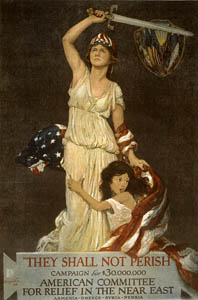 "They shall not perish"
"They shall not perish"
The contribution poster of Near East Relief, 1918
This massage was transmitted to James L. Barton, Foreign Secretary of the American Board of Commissioners for Foreign Mission in Boston. On September 14 Barton wrote to Cleveland H. Dodge, the long time friend of the benevolent and missionary organizations working in the Near East in New York and offered him to convene a comprehensive conference on Armenian matters.
On September 16 a group of affluent people agreed to organize a committee for the purpose of raising funds for suffering Armenians and to send aid to Constantinople for relief purposes.
Since October the 1st of 1915 Armenian Relief Committee started contributing to this project. There were two more committees operating in the Near East: Syrian and Palestinian Relief Committee and Persian War Relief Foundation. In November, 1915, these two committees united with Armenian Relief Committee functioning as Armenian and Syrian Relief Committee, later known as the American Committee for Relief in the Near East. On August 6, 1919, the U.S. Congress issued a Charter signed by the U.S. President incorporating the Near East Relief.
 American president W. Wilson’s proclamation to the
American president W. Wilson’s proclamation to the
American society for contributing
Armenians and Syrians
Among the founders and members of The Near East Relief were Cleveland H. Dodge, Woodrow Wilson’s friend and the Chairman of the Board of Trustees of Robert College at Constantinople, James L. Barton, Charles R. Crane, President of the Board of Trustees of the Constantinople College for Women, Samuel T. Dutton, Treasurer of the Constantinople College for Women and the Secretary of World Peace Foundation, Stanley White, Edwin M. Bulkley, William I. Chamberlain, Charles Vickrey and many other prominent individuals.
During the meeting a question was raised about the amount of money the Committee should aim to raise. Various opinions were expressed and the sum of $100.000 was affirmed. Cleveland H. Dodge took the responsibility to meet all the expenses of the office. The Chairman and the Treasurer of the Committee proceeded to Washington and established connections with the Department of State. The entire files of the Department were placed at their disposal. They were given permission to read and use any and all dispatches and documents stating religious, social and physical conditions in the disturbed areas. The situation far surpassed anything that had been imagined in terms of the conditions among the native non-Moslem populations in Ottoman Empire.
A few months after the formation the Committee had more than 50 centers in Constantinople, Izmir, Marzvan, Aintab, Diarbekir, Urfa, Kharberd, Erzerum, Trabzond, Bitlis, Van, Tavriz, Urmia, Aleppo, Beirut, Damask.
The President of the United States, Woodrow Wilson, was keenly aware of the situation in the Near East and firmly believed that America should do its part in humanitarian effort to relieve the distress among the war-stricken people overseas. Through his personal friendship with Mr. Dodge and Mr. Crane he assured the Committee on the Near East issue was formed and acting.
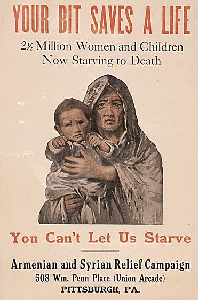 "Your bit saves a life"
"Your bit saves a life"
Armenian and Syrian Relief Campaign
On July 10, 1916, the Congress passed a joint resolution requesting the President to authorize a special day for a nation-wide consideration of the critical condition of the Armenian people and ask the citizens of the country to show generosity and support the relief project. On August 31, 1916, President Wilson declared Saturday, October 21, and Sunday, October 22, as joint days upon which the people of the United States may make contributions for to support the stricken Syrian and Armenian people.
Hundred thousands of Armenian refugees from Ottoman Empire were reaching Armenia.
In order to help them American Consul in Tiflis, Willoughby Smith, turned to the Committee for help. As a response the Rockefeller Foundation made large contribution.
 "Lest we perish"
"Lest we perish"
American Committee for Relief in The Near East
In 1916 the operation of the Committee extended. The cables sent by American Consul J. Jackson informed about approximately 150.000 refugees in Aleppo, Deir-ez-Zor and Damask. More than 2000 orphans were situated in the churches and other Aleppo institutions.
Although The U.S. broke diplomatic relations with Turkey in 1917, when America entered the war, it did not affect the attitude of the Turkish government towards the relief work. Diplomatic representatives returned to America, but most of other Americans remained at their stations.
Soon after the Turkish settlement, relief projects were summoned not only in Caucasus, Syria and Lebanon, but also in inner regions of Ottoman Empire. The contributions went to the relief of more than 12.000 Armenian orphans in Kharberd, Sivas, Trabzond, Samsun, Marzvan, Gonia, Izmit, and Caesarea, Brusa, Partizak, Adana and many others.
In 1919, in Alexandropol thousands of Armenian orphans were taken off the streets, given a thorough medical examination and later placed either to orphanages or hospitals as needed.
In some orphanages the number of children was exceeding 25.000. Despite of that the children in Caucasus were fed three times a day. The orphanage of Alexandropol probably was the largest one in the history and it was called “Orphan City”.
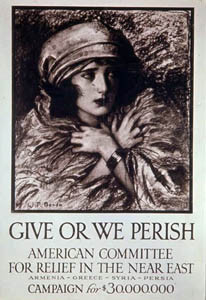 "Give or we perish"
"Give or we perish"
American Committee for Relief in The Near East
Although in November, 1920, Armenia passed under Soviet rule, the Near East Relief was allowed to continue its efforts as it had no political objectives, motives or purpose.
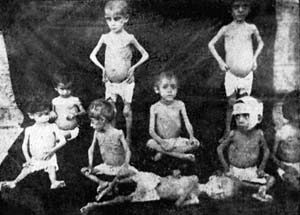 Children taken in by Near East Relief
Children taken in by Near East Relief
Tessa Hofmann & Gerayer Koutcharian
Armenian Review, Spring/Summer, 1992, Vol. 45, No. 1-2/177-178, p. 119, Fig. 56
Governmental as well as international support was essential to provide shelter and feed hundreds of thousands of refugees. In 1922 American Red Cross provided $3.000.000 to the Near East Relief. Later this sum increased up to $6.000.000.
The Committee organized relief in more than 300 centers in the Near East, and 100 more in Eastern Armenia.
The orphanages of Kharberd, Malatya, Diarbekir, Mardin, Urfa, Marash and Adana were replaced to Syria, where there was room neither in orphanages nor in schools. It was vital to organize a new relief campaign for 12.000 Armenian orphans in Syria.
1923 was announced the “Golden Rule Sunday”. November 10 and 11 were considered to be special days for organization of relief among all the citizens of United States. This initiative had great success; therefore, December 6, 1925 was announced a “Golden Rule Sunday”.
During this year huge amounts of donations were made and the sum reached $4.265.322. Later this campaign became an international one and included 51 more countries.
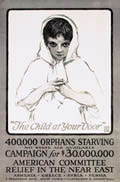 "400.000 orphans starving"
"400.000 orphans starving"
American Committee for Relief in The Near East
The Near East Relief took not only the responsibility of the vocational education of orphans but also of finding a work place for them, allocating them to proper families, and supporting them by any other means necessary.
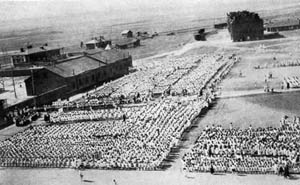 Group of Near East Relief orphan girls at summer camp
Group of Near East Relief orphan girls at summer camp
Polygon orphanage massed drill, October, 1925
“Story of Near East Relief” by James L. Barton, New York, 1930, p. 21
The releasing of orphans from the orphanages started in 1925 and continued till 1929-1930, when orphanages were closed down. No orphan with disputable status left the orphanage. They were under control of the organization for some period. The adults were working and creating Armenian families. But this part of the job was controlled by a new organization - Near East Foundation - the descendant of the Near East Relief.
Founded as a temporary committee Near East Relief became a large organization which put a goal to meet $100.000, but raised $110 million for refugees and orphans in the Near East. That humanitarian aid was contributed by American missionaries, 30 of whom fell victims to various diseases and accidents.
Due to the efforts of the Near East Relief and humanitarian aid of American government and Americans hundreds of thousands of Armenians and thousands of other nationalities of the Near East were rescued from extermination. The activities of the Near East Relief became one of the glorious pages of the history of the humanitarian movement.





